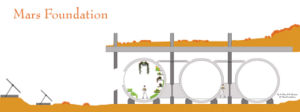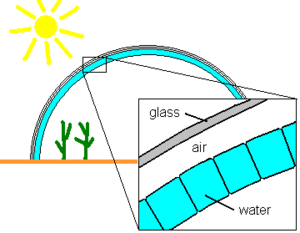Radiation shielding
Shielding against radiation is considered a very difficult task. For example, a proton or alpha particle cosmic ray of "medium" energy can pass through more than a metre of aluminium, not counting the effects of secondary radiation[1]. With this in mind, it is clear that any Martian colonists would have to take a holistic approach, reducing their radiation exposure at every possible opportunity through shielding and risk-mitigating behaviour.
Passive shielding

In most cases, matter placed between a person (or radiation-sensitive equipment) and radiation source reduces the amount of radiation they absorb. The effectiveness of the shielding increases with the mass of the shielding and decreases with the atomic mass of the elements used for the shielding. For example, 1kg of hydrogen offers more protection then 1kg of aluminium, 2kg of aluminium offers more protection than 1kg of aluminium and 1kg of hydrogen offers more protection than 2kg of aluminium.[2]
Mars One's solution is a thick layer of regolith on top of the settlement modules. An effective shield will require at least several hundred grams of regolith per square centimeter, according to one study.[3] Using a regolith density estimate of 1.4 g/cm3[4], this means the regolith layer would need to be over 2 meters deep.
Active shielding
Active shielding against radiation involves a manmade magnetic field which deflects ionized particles in the same manner as the Earth's. Such fields would require infeasible amounts of energy to generate and would also pose a major risk to anyone approaching the craft or base, as it would create bands of trapped particles similar to the Van Allen belts.[1]
Nevertheless, it might be possible to situate a base in such a location that one of the residual Martian magnetic fields offers a nett benefit. Care should certainly be taken not to situate it where the fields concentrate radiation.
Also, it might be possible (assuming one could generate the required magnetic field in some way) to have the radiation belts of the habitat pass through some sort of physical barrier, which scrubs them of particles.
Risk-mitigating behaviour
The possible sources of radiation on Mars are manmade sources, such as nuclear reactors or medical equipment, solar radiation, galactic cosmic radiation and naturally occuring radioactive elements on Mars.
Possible behavioural choices which minimize the risk from these include:
- Avoiding daytime EVA when there is a significan risk from solar radiation.
- Working preferentially close to natural or manmade objects, such as habitats, rovers or cliffs which provide additional (if not omni-directional) shielding.
- Entering a storm shelter when there is a high-radiation risk from solar particle events.
References
- ↑ Jump up to: 1.0 1.1 Operational medicine and health care delivery - J.S. Logan, in S.E. Churchill ed. Fundamentals of space life sciences, Volume 1 - 1997, ISBN 0-89464-051-8 pp. 154-156.
- ↑ Radiation biology - J.R. Letaw, in S.E. Churchill ed. Fundamentals of space life sciences, Volume 1 - 1997, ISBN 0-89464-051-8 pp. 16-17.
- ↑ Slaba, T. C., Mertens, C. J., & Blattnig, S. R. (2013). Radiation Shielding Optimization on Mars. NASA/TP–2013-217983. Retrieved from https://ntrs.nasa.gov/archive/nasa/casi.ntrs.nasa.gov/20130012456.pdf
- ↑ Kim, M. Y., Thibeault, S. A., Simonsen, L. C., & Wilson, J. W. Comparison of Martian Meteorites and Martian Regolith as Shield Materials for Galactic Cosmic Rays. NASA TP-1998-208724. Retrieved from https://ntrs.nasa.gov/archive/nasa/casi.ntrs.nasa.gov/19980237030.pdf.







